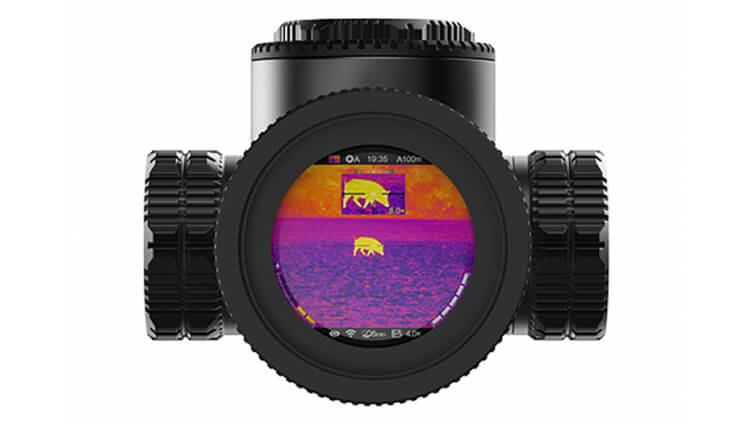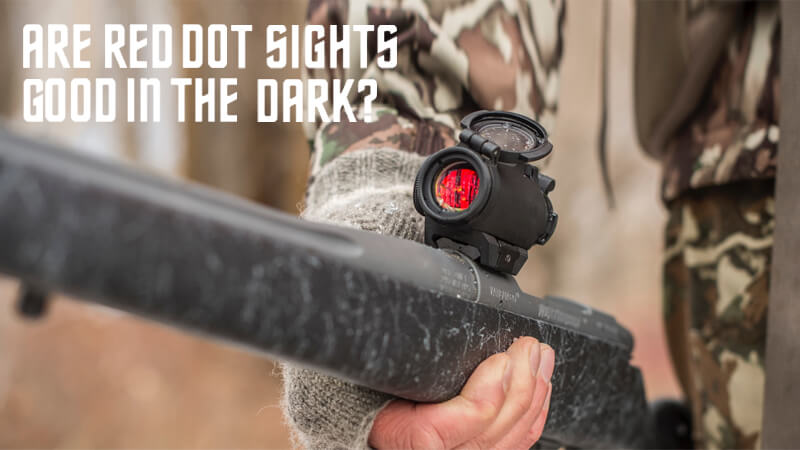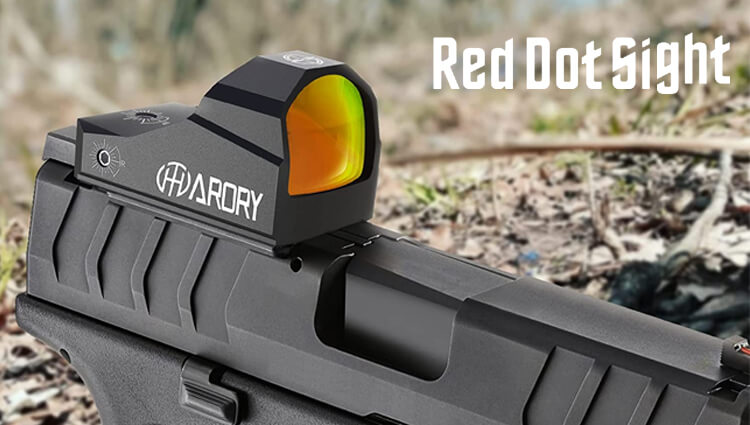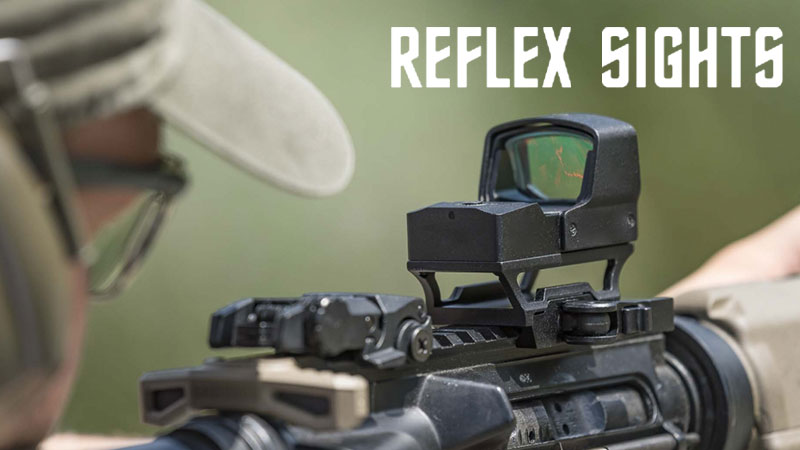Shooting in the dark requires good sight to hit your target. Different types of sights offer specific advantages and drawbacks. Therefore, it’s important to research before making a purchase. One question that comes up often is whether “Are red dot sights good in the dark?”
If you’ve ever asked this same question, the answer may surprise you! Red dot sights stray away from the traditional Night Vision Device (NVD). However, they can still be useful in dark areas.
We’ll examine how these specialized optics function and go through their benefits and drawbacks for nighttime shooting.
What is red dot sight?
Red dot sights are a type of optic frequently used in firearms, mainly rifles, and pistols, to help with aiming. They generate a tiny, lit red dot onto a lens, which the shooter centers on the target.
The sight enables both shootings with both eyes open and rapid acquisition of the target. This gives you a larger field of vision and better situational awareness. Red dot sights are common for hunting, tactical situations, and shooting sports.
Different types of red dot sights
Red dot sights are popular aiming devices used in firearms, archery, and other shooting sports. There are several varieties of red dot sights available, including:
- Tube-style red dot sight: This optic has a cylindrical body with a lens at the front and a reticle or dot in the center. The lens collects light and reflects it onto the reticle, which appears to be projected onto the target.
- Reflex sight: Reflex sights are also tube-style red dot sights, but they have an open design with no front lens. Instead, the reticle is projected onto a reflective surface, which is usually a curved lens or a prism.
- Holographic sight: These use holographic technology to project a reticle onto the target. They have a window or lens at the front of the sight and use a laser to create the reticle image.
- Prism sight: These use a prism to reflect the reticle onto the target. They are often smaller and more compact than tube-style sights, making them a good choice for rifles with limited rail space.
- Mini red dot sight: These are compact and lightweight, making them a popular choice for handguns and shotguns. They typically have a small window and a simple reticle, making them quick and easy to use.
Each type has its own advantages and disadvantages, so it’s important to choose the right one for your specific needs and shooting style.
Red dot sight vs Iron sight
Many shooters prefer red dot sights over conventional iron sights when it comes to shooting in low-light areas.
The rationale is that a red dot sight has a broader field of view, which makes it simpler to acquire targets in poorly light locations. Red dot sights also provide a clear sight picture with a single point of reference, unlike iron sights need the front and rear sights to be lined up for precise shooting.
Shooters can fine-tune their aim for increased precision using red dot sights’ changeable MOA (minute of angle) settings. In contrast, iron sights typically have fixed rear sight notches and require more manual adjustments for sighting in low-light conditions.
Overall, a red dot sight can be a reliable choice for shooters looking for improved accuracy and ease of use in low-light settings.
Why does red dot sight work in night vision?
Red dot sights work in NVD because red dots provide a clear and bright point of aim that is easily visible in low light conditions without disrupting the user’s night-adapted vision. The red color of the dot is also less likely to be noticed by animals or other people, making it ideal for use in hunting or tactical situations.

What functions do night vision red dot sights have?
Red dot sights generate a red light visible in low light but not so bright as to interfere with the night optic image. Therefore, they are used together with NVD. In addition, target acquisition is quick and precise because of the red dot. This acts as an aiming point superimposed on the target.
Some red dot sights are also made expressly to function with NVD and include brightness settings that may be changed to improve their visibility with the apparatus.
Types of Night Vision and Their Uses
The two primary categories of NVDs are:
- Thermal Imaging: NVD that uses infrared light to find heat signatures. Based on that data, it generates an image. It is frequently employed in military and law enforcement applications, as well as in search and rescue operations, hunting, and animal monitoring.
- Image Intensification: Image intensification combines light amplification with image modification to create a visible image in low light. Application areas for it include security, surveillance, and hunting.
The advantages and restrictions of each form of NVD are distinct. Which to use will rely on the user’s particular requirements and the environment in which the device will be utilized.
The pros and cons of using red dot sight in night vision
Pros:
- Increased targeting speed and accuracy.
- It is simpler to acquire targets at close ranges since no magnification exists.
- Brightness can be changed for usage in dark areas.
- It is more night vision compatible.
Cons:
- Batteries last less time when using a red dot reticle.
- In exceedingly dark surroundings, it may not be as visible.
- For long-range shooting, it might be less effective.
- Glare or light reflection may cause interference.
The best Night Vision optics for red dots
Combining red dot optics with different NVD is possible. Consider the following choices:
- Thermal Scopes:These scopes pick up infrared radiation given off by targets and build an image based on temperature variations. These optics can be easier to see through smoke and fog and function well in total darkness.
- Clip-on NVDs: These optical devices attach to the front sight and amplify available light to provide night vision capabilities. They are easy to use and deliver good clarity in unlit conditions.
- Digital scopes: These scopes display and capture images using digital sensors. These can generate a lower-quality image than other options, but they are frequently more economical than alternatives and may offer extra functionality like video recording.
- Dedicated Scopes: These night optic-specific scopes offer superb clarity and range in total darkness. For accurate shooting, they frequently have reticles and adjustable magnifiers.
While searching for night optics lenses for red dot sights, prominent manufacturers to take into account include ATN, FLIR, and Pulsar. It’s critical to pick an optic appropriate for your particular red dot sight that satisfies your usability, range, and clarity requirements.

Red dot sight can be used with many night vision devices; among the best are:
- ATN X-Sight 4K Pro: This expensive night optics scope features an integrated red dot sight and 4K resolution.
- Armasight Orion 5x Gen 1+ Night Vision Rifle Scope: This option offers crisp and vivid night optic images at a reasonable price. It fits most rifles easily and is compatible with red dots.
- Pulsar Apex XQ38: The images from this digital night optics scope are high caliber, even in dim lighting. Real-time zooming is offered, and a red dot sight is built in.
- FLIR Breach PTQ136: This thermal imaging monocular provides excellent imaging in complete darkness. It’s compatible with red dots and is highly portable.
- Night Owl Optics NOXM50: This low-cost NVD monocular provides bright and clear images. It can be mounted on a rifle or used as a handheld device.
Remember that there are many other market options; these are just a few examples. To make the best decision, consider your distinct needs and budget when selecting a night optics lens with a red dot.
Recap
Red dot sights are used in guns and the NVD to help with aiming, ensuring the point of aim and point of impact always coincide. Additionally, providing a clear and bright point of aim that is less likely to be noticed by animals or people. They are useful for hunting, tactical situations, shooting sports, and other applications such as search and rescue missions.
Red dot sights are a useful tool in conjunction with NVDs, providing accurate and faster target acquisitions in low-light conditions. However, they do have some limitations, such as reduced effectiveness in very dark environments and potential battery life issues.
Ultimately, the choice of using a red dot sight with night vision will depend on the user’s specific needs and the environment in which they are operating.
Takeaway
Red dot sights are a handy tool for any shooter trying to boost accuracy and precision in low-lighting circumstances. They are perfect for hunting or self-defense since they make it easier for a shooter to acquire a target quickly and improve visibility at night. These sights are among the market’s most widely used sighting choices, thanks to their practical design and affordable prices.
Whether you’re a novice shooter or an experienced marksman, investing in a red dot sight will give you the edge in nighttime shooting. Get one today and enjoy those dimly lit dawns and dusks like never before!
FAQs
Can night vision see through walls?
No, night vision equipment is unable to penetrate solid walls. Since this technology depends on the light there, it cannot see through absolutely opaque objects.
What is the maximum range of night vision devices?
A night vision device’s maximum range is influenced by a number of variables, including the device’s quality, the amount of light present in the surrounding area, and the size and contrast of the objects being examined.
Generally speaking, the range of most NVD is several hundred meters. However, this can vary greatly depending on the particular device and environmental factors.
What are some common uses for night vision technology?
The military and law enforcement frequently use night vision technology for target acquisition, navigation, and surveillance. Besides being employed for specific industrial and scientific purposes, it is also utilized by hunters and wildlife enthusiasts.
What is the difference between monocular and binocular night vision devices?
Monocular devices for night vision have a single eyepiece and are often more compact and lightweight. In addition, the viewing experience is more natural with binocular gadgets because they feature two eyepieces. As a result, binocular tools are frequently selected for prolonged usage or when depth perception is crucial.
How does night vision work?
Night vision technology functions by boosting ambient light. Image enhancement and thermal imaging are the two basic categories of these technologies. Input light is transformed into electrons via a photocathode in image enhancement devices, amplifying and transforming the electrons back into visible light.
On the other hand, thermal imaging uses heat signatures from the surroundings to detect the heat given off by nearby objects and create an image.
What are the different generations of night vision technology?
Four generations are commonly used to classify night vision technology. The 1960s saw the introduction of the first-night optics technology, which had a low resolution and a short range. The 1980s saw the introduction of second-generation devices, which provided better resolution and range.
A gallium arsenide layer was added to the image intensifier in third-generation devices, first presented in the 1990s and offered improved image quality. Fourth-generation systems, commonly called “filmless” NVD, use a different kind of photocathode to create even greater image quality.









Leave A Comment
You must be logged in to post a comment.